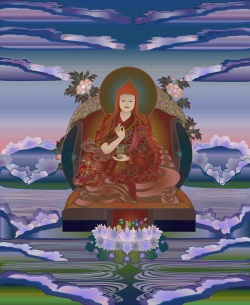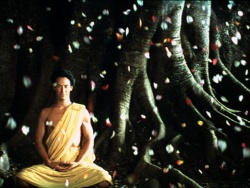There is no Pure Buddhism
December 1, 2011 by Justin Whitaker
Several topics have been bouncing around my head lately all somewhat revolving around the above idea: there is no pure Buddhism.
All Buddhism is syncretic (borrows from multiple traditions sources). The Buddha himself was syncretic, the Abhidhammists/Abhidharmists were syncretic (see Noa Ronkin’s recent great work, Early Buddhist Metaphysics), early Mahayana, as far as we can tell, was syncretic, and so on and so forth. So when scholars or others point at Tantric Buddhism and say, “that’s not Buddhism, but a syncretic blend of…” they’re simply missing out on the history of Buddhism.
Today in a Buddhist Studies group discussion, the notion of Tantric Theravada came up. Based on how many of us are taught Buddhism that would be a contradiction in terms, but it exists (in Thailand in this case, I believe).
That’s not to say we can’t get close to an idea of what Candrakirti or Dogen or the Buddha really taught and understood (as opposed to the (mis)-understandings of some of their followers). That’s what scholarship is all about, and indeed a great number of practitioners will engage in the same kind of work: dissecting texts, looking for clues to abnormalities, trying to judge why different ideas are presented at different times, perhaps discovering and demonstrating that certain ‘teachings’ held to be authentic are in fact apocryphal, and so on.
I don’t know the history of Biblical scholarship all that well, but there were periods when scholars either searched for “the historical Jesus” or, at the other extreme, suggested that there is no real evidence for us to even talk about Jesus having existed. Today it seems that scholars of Buddhism are riding the same wave.
The word ‘tradition’ is fuzzy. My thanks to Erick’s comment on my post on Buddhist Modernism for spurring this on. Next time you’re listening to someone talk about Buddhism and they drop the word tradition, or traditional, ask them exactly what they mean by that. If they say that “traditionally, Thailand is a Theravada only country” ask if that means there is no Mahayana, or never was any, or if there are any Mahayana influences on the Theravada today… Odds are, unless they’re fairly well versed on Thai Buddhism, they’ll either pound some sort of party line: Thai Buddhism is and always was Theravada! Or they’ll get get a bit uncomfortable…
Often, appeals to tradition are just dropped as if they should not be questioned; and yet the vagueness of ‘tradition’ makes such appeals at least border on Argumentum ad verecundiam – which is precisely why they should be poked and prodded.
And another tiny thought on McMahan’s book… While he suggests that Buddhist Modernists have borrowed from aspects of (primarily) 19th century Western thought in recent times, it may be just as much the case, if not more that Buddhist Modernists have simply been reacting to the same geo-political, intellectual, and economic circumstances that Westerners faced 200 years ago.That is to say, taking the ‘nature/environmental thought’ example I used in my recent post, that it might not be the case that much of Buddhist Modernism has anything to do with Western Romantics or Transcendentalists in terms of any verifiable causal relationship. It may be rather that the Romantics and Transcendentalists were responding to features like rapid economic change, social upheaval, and understandings of global networks in much the same way as Asian Buddhists of the 20th and 21st centuries have. All of these rapid changes simply occurred later in most of Asia, allowing for the appearance of causal connections between the resulting changes in popular ideology.
To put it in simpler terms (for some), McMahan has presented a Hegelian – “flow of the Geist, or Spirit of Ideas” model, while I would suggest a more Marxist, ground-up understanding. Look at the physical conditions that produced these waves of thought, instead of treating history like a bunch of disembodied thinking things.
Another example that might help my case is that of the secularization of Britain and Japan. It’s not the case that European secular ideas influenced Japan after WWII, but rather that Japan’s similar experience of the horrors of ideologically fueled warfare and subsequent calm and economic boom led to a more secular state just as it did in much of Europe. Of course the many factors involved are incredibly complex, which is why I would probably not dare venture into attempting to prove such a thesis even in a very long book.
There is no privileged position from which to describe Buddhism – or any religious phenomenon, for that matter. In today’s Buddhologist gathering, we examined a chapter of Gavin Flood’s Beyond Phenomenology: Rethinking the Study of Religion. With a title like that… I’ll let you complete the sentence. In any case we get a good overview of the history of ways of studying religion and potential flaws in them. It brings me back, a bit, to a post I wrote here (as well as at Progressive Buddhism) about modes of authenticity in Buddhism. It’s still a rather unformed thesis there and now, but essentially, there are various ways to understand truth-claims. I had written that the “Spiritual” dimension – or here, “phenomenological” or experiential – was not really a realm for scholars to worry too much about.
I suppose that in a sense that is wrong, insofar as scholars ARE looking at the experiential claims of Buddhists. They aren’t looking at them to determine whether they are true, but rather to determine whether claims about experiences are a part of Buddhist tradition :) or whether they represent a relatively new phenomenon in Buddhism.But I digress. The upshot of the study, for me, was something that I have long thought to be necessary in any kind of scholarship: to look at the topic from various perspectives. If you’re talking about Zen sitting practice, find the doctrinal sources, interview monks about their experience, and do comparative analysis with coexisting/competing traditions. There is no one source that will give the definitive truth of what is going on. Too often people, from practitioners to Post-modernists get on a hobby-horse about having the definitive and complete explanation of a broad and diverse religious phenomenon. They simplify it down to “all x is y” in some appealing rhetoric and support it with various examples, conveniently leaving out the problematic counterexamples. But little in life really holds up to such simple/simplistic “all x is y” categorization.
Life is messy. Religion is messier.
And the study of living religion, by living beings: an utter shitstorm, kid.

